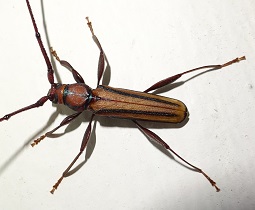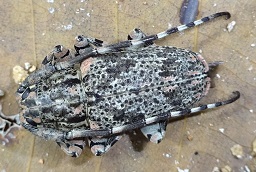| Home | Nature Weekly Index |
7 September 2014 | Longhorn Beetles | Family: Cerambycidae |
 It did not surprise me when I saw this longhorn beetle last Saturday afternoon from a distance away since longhorn beetles were
frequent visitors of my home. This particular beetle was latching onto the base of a leaf from the
Air Potato Vine (Dioscorea bulbifera) growing along the corridor just outside
my home. The surprise came when I inched closer to examine it. It was a totally new longhorn beetle to me, different from those that
frequent my place from the nearby park. Needless to say, I had no any picture of this particular fellow. I immediately grabbed my
camera and added another new longhorn beetle pictures to my collection. Despite a heavy downpour cum wind shortly that shook the
leaf vigorously, the beetle remained steadfastly on the same location. The next day, it had migrated to the wall of the corridor
and stayed there throughout the day. It eventually disappeared on Monday morning. Based my research, this is an Albizia Borer
(Xystrocera festiva) that drills tunnels through the stem of the
Albizia tree (Falcataria falcata) [1]. It also have a special liking of other
tree species in the Fabaceae family.
It did not surprise me when I saw this longhorn beetle last Saturday afternoon from a distance away since longhorn beetles were
frequent visitors of my home. This particular beetle was latching onto the base of a leaf from the
Air Potato Vine (Dioscorea bulbifera) growing along the corridor just outside
my home. The surprise came when I inched closer to examine it. It was a totally new longhorn beetle to me, different from those that
frequent my place from the nearby park. Needless to say, I had no any picture of this particular fellow. I immediately grabbed my
camera and added another new longhorn beetle pictures to my collection. Despite a heavy downpour cum wind shortly that shook the
leaf vigorously, the beetle remained steadfastly on the same location. The next day, it had migrated to the wall of the corridor
and stayed there throughout the day. It eventually disappeared on Monday morning. Based my research, this is an Albizia Borer
(Xystrocera festiva) that drills tunnels through the stem of the
Albizia tree (Falcataria falcata) [1]. It also have a special liking of other
tree species in the Fabaceae family.

 Several weeks back on the night of 21 August, I had another longhorn visitor. It was a rather common
Leopard Spot Longhorn Beetle (Coptops leucostictica).
This fellow can be found on diseased or dead trunk of
Rubber tree (Hevea brasiliensis). Unlike the Albizia Borer above, I was not
able to find any report that shed more light on the Leopard Spot Longhorn Beetle although the latter beetle appears to be much more
common than the former one.
Several weeks back on the night of 21 August, I had another longhorn visitor. It was a rather common
Leopard Spot Longhorn Beetle (Coptops leucostictica).
This fellow can be found on diseased or dead trunk of
Rubber tree (Hevea brasiliensis). Unlike the Albizia Borer above, I was not
able to find any report that shed more light on the Leopard Spot Longhorn Beetle although the latter beetle appears to be much more
common than the former one.
One other longhorn beetle that usually co-exist on the trunk of the Rubber tree is Coptops lichenea. One interesting behaviour of Coptops annulipes is that it will act dead by bringing the limbs and antennae close to the body, and remain motionless for an extended period of time when it encounters thread. Most other longhorn beetles will simply flew off immediately. Similar to Coptops leucostictica, both have many pictures displayed in the Internet but no specific in depth report on its affiliation or interaction in the wild.
The 4th longhorn beetle that is available in the nearby park is the colourfully spotted Olenecamptus optatus. This one is classified as a pest of Mango tree (Mangifera indica). Indeed, I had found it on 2 occasions feeding on the leaf of the Mango tree. The 2 occasions happened over 5 years over my frequent visit to this park, with the latest sighting in April this year. Hence, I would considered it as a rare species.
Reference:
[1] AH Endang and H Noor Farikhah. Infestation of Xystrocera festiva in Paraserianthes falcataria plantation in East Java, Indonesia. Journal of Tropical Forest Science 2010;22(4):397-402. | Read article |
Update: 22 September 2014
Apparently, the longhorn beetle above is not an Albizia Borer (Xystrocera festiva). David Moh from Beetles@SG Blog had kindly advised me that it is a Xystrocera globosa instead. A picture of the real Xystrocera festiva is available at the Longhorn Beetles of Singapore website. They do look very similar.
Update: 7 March 2017
When I tried to access the Longhorn Beetles of Singapore website, I realised that it was closed. Fortunately, there was another good online pictorial resource of longhorn beetles in Singapore being set up by Nicky Bay.